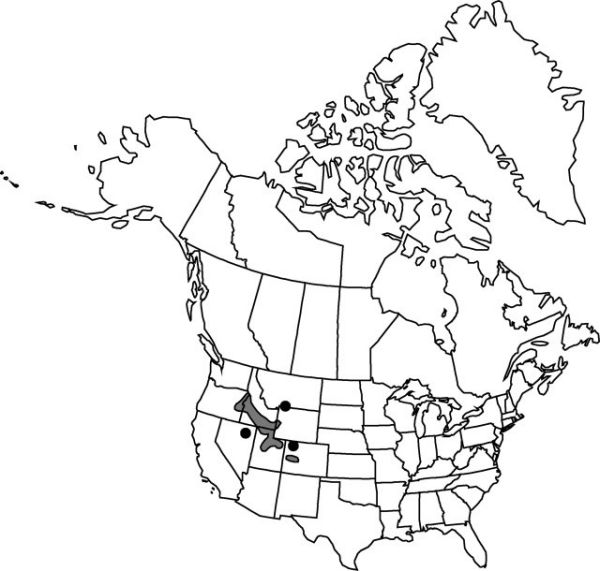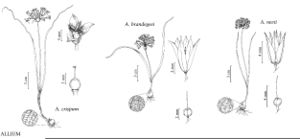Allium brandegeei
Proc. Amer. Acad. Arts 17: 380. 1882.
Bulbs 1–5, not clustered on stout, primary rhizome, ovoid to globose, 0.7–1.5 × 0.6–1.4 cm; outer coats enclosing 1 or more bulbs, brown to grayish brown, membranous, usually distinctly cellular-reticulate, cells isodiametric or ± narrowly hexagonal, transversely elongate, without fibers; inner coats red to purple or white, cells obscure, quadrate to ± transversely elongate. Leaves usually persistent, green at anthesis, 2, basally sheathing, sheaths not extending much above soil surface; blade solid, flat or channeled, ± falcate, 8–27 cm × 1–3 mm, margins entire. Scape persistent, solitary, erect, solid, terete, 3–10(–20) cm × 1–3 mm. Umbel persistent, erect, compact, 8–25-flowered, hemispheric, bulbils unknown; spathe bracts persistent, 2, 7–10-veined, ovate, ± equal, apex acuminate. Flowers campanulate, 5–8 mm; tepals erect, white with prominent green to purplish midvein, lanceolate to elliptic, ± equal, becoming involute at tip and rigid in fruit, margins entire, apex obtuse to acuminate; stamens included; anthers yellow; pollen yellow or white; ovary crestless or obscurely crested; processes 3, low, rounded, central, margins entire; style linear, equaling stamens; stigma capitate, scarcely thickened, unlobed; pedicel 5–15 mm. Seed coat shining; cells smooth. 2n = 14.
Phenology: Flowering late Apr–Jul.
Habitat: Sandy, rocky soil
Elevation: 1200–3300 m
Distribution

Colo., Idaho, Mont., Nev., Oreg., Utah, Wyo.
Discussion
Selected References
None.
